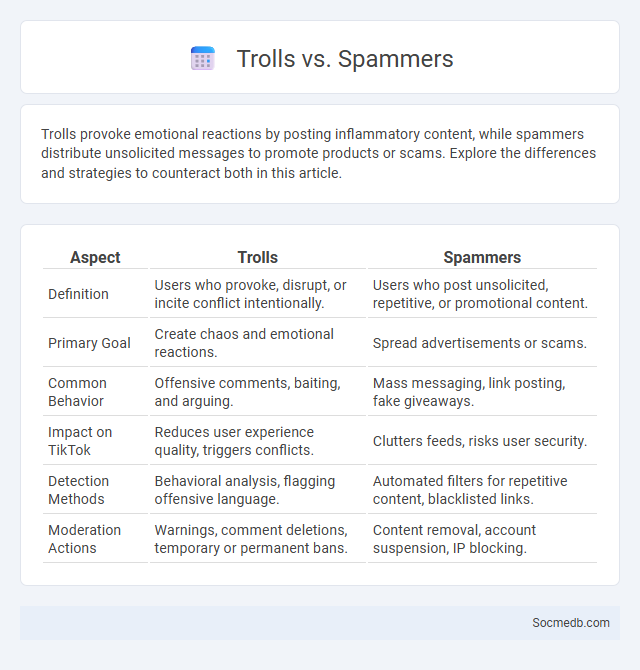
Photo illustration: Trolls vs Spammers
Trolls provoke emotional reactions by posting inflammatory content, while spammers distribute unsolicited messages to promote products or scams. Explore the differences and strategies to counteract both in this article.
Table of Comparison
| Aspect | Trolls | Spammers |
|---|---|---|
| Definition | Users who provoke, disrupt, or incite conflict intentionally. | Users who post unsolicited, repetitive, or promotional content. |
| Primary Goal | Create chaos and emotional reactions. | Spread advertisements or scams. |
| Common Behavior | Offensive comments, baiting, and arguing. | Mass messaging, link posting, fake giveaways. |
| Impact on TikTok | Reduces user experience quality, triggers conflicts. | Clutters feeds, risks user security. |
| Detection Methods | Behavioral analysis, flagging offensive language. | Automated filters for repetitive content, blacklisted links. |
| Moderation Actions | Warnings, comment deletions, temporary or permanent bans. | Content removal, account suspension, IP blocking. |
Understanding Trolls: Motives and Methods
Social media trolls often seek attention, provoke emotional responses, or disrupt online communities by posting inflammatory or off-topic messages. Their methods include spreading misinformation, impersonating others, and exploiting platform algorithms to amplify negativity. Recognizing these motives and tactics is essential for developing effective moderation strategies and fostering healthier online environments.
Defining Spammers: Tactics and Techniques
Spammers on social media employ automated bots, fake profiles, and phishing links to disseminate unsolicited content and manipulate engagement metrics. Common tactics include mass messaging, hashtag hijacking, and comment flooding to amplify visibility and spread malware or fraudulent schemes. Understanding these techniques is crucial for developing effective detection algorithms and enhancing platform security.
Trolls vs Spammers: Key Differences
Trolls on social media deliberately provoke and disrupt conversations by posting inflammatory or off-topic messages to elicit emotional responses, whereas spammers primarily aim to promote products, services, or scams through repetitive and unsolicited messages. Troll behavior targets individual users or communities to create conflict, while spammers use automated or bulk messaging tactics to reach a broad audience indiscriminately. Understanding these differences is essential for effective content moderation and safeguarding online interactions.
Types of Online Trolls Explained
Online trolls can be categorized into several types, including flame trolls who provoke conflict by posting inflammatory comments, and bait trolls who deliberately post controversial content to elicit emotional reactions. Other types are griefers, who aim to disrupt communities and servers, and concern trolls, who disguise criticism under the guise of helpful advice. Understanding these distinct troll profiles helps experts develop targeted strategies for managing toxic behavior on social media platforms.
The Evolution of Internet Spamming
Internet spamming has evolved from simple email floods to sophisticated social media campaigns targeting billions of users daily. Malicious actors now exploit platforms like Facebook, Instagram, and Twitter to spread phishing links, fake news, and unsolicited advertisements, leveraging AI-generated content to bypass detection. Protecting Your online presence requires vigilant use of privacy settings, spam filters, and awareness of emerging tactics used by spammers.
How Trolls Impact Online Communities
Trolls disrupt online communities by spreading misinformation, provoking emotional responses, and diminishing the quality of discussions. Their toxic behavior can drive away genuine participants, eroding trust and engagement within the platform. Protecting your online space requires proactive moderation strategies to maintain a positive, respectful environment.
Spammers’ Effects on Digital Platforms
Spammers on digital platforms dilute user experience by flooding social media feeds with irrelevant and deceptive content, leading to reduced engagement and trust among genuine users. These malicious actors exploit platform algorithms to amplify misinformation, erode brand credibility, and increase cybersecurity risks such as phishing and malware distribution. Effective spam detection and removal techniques are crucial for maintaining platform integrity, safeguarding user data, and promoting authentic social interaction.
Strategies to Identify Trolls and Spammers
Effective strategies to identify trolls and spammers on social media include analyzing user behavior patterns such as frequent posting of provocative content, repetitive comments, and irrelevant links. Utilizing advanced algorithms and AI-powered tools can detect fake accounts by examining profile inconsistencies, sudden follower spikes, and engagement anomalies. You can protect your online community by setting strict moderation rules and regularly monitoring for suspicious activity to maintain a safe and authentic environment.
Preventing and Responding to Online Abuse
Online abuse on social media can significantly impact Your mental health and digital presence, making prevention and response strategies essential. Utilize privacy settings, block or report abusive users, and document incidents to protect Yourself and others. Engaging with platform support and seeking legal advice when necessary ensures a safer online environment.
Building Safer Online Spaces: Moderation Best Practices
Effective moderation best practices enhance the safety of online spaces by implementing clear community guidelines, employing advanced AI tools for content monitoring, and fostering user reporting mechanisms. You can promote respectful interactions and minimize harmful content by training moderators to recognize and address harassment, misinformation, and inappropriate behavior promptly. Consistent enforcement and transparent communication build trust and improve overall social media experience for every user.
 socmedb.com
socmedb.com